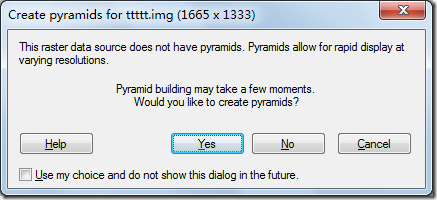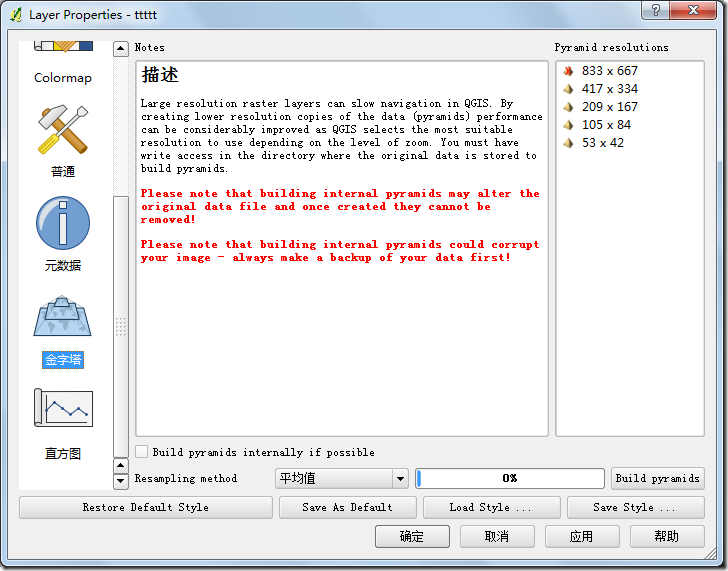今天在使用GDAL打开大的img文件的时候,(这里所谓的大文件指的是img文件太大,会将数据文件存放到ige格式raw文件中)。在讲img文件和ige文件重命名后,使用GDAL打开文件后,只能读取到文件信息,不能读取图像的数据文件。仔细查看GDAL源代码发现,在img文件中记录了对应的ige文件的名称,重命名后img文件中的记录ige文件名还是原来的,找不到ige文件,所以就打不开了。但是在使用Erdas和ArcGIS打开该文件时,会正常打开,于是查看GDAL代码,修改部分代码,能够使GDAL正常打开。
修改的代码位置如下,gdal源代码目录/frmts/hfa/hfaband.cpp中 367行处的代码修改为下面的:
/* -------------------------------------------------------------------- */ /* Open raw data file. */ /* -------------------------------------------------------------------- */ const char *pszRawFilename = poDMS->GetStringField( "fileName.string" ); const char *pszFullFilename; pszFullFilename = CPLFormFilename( psInfo->pszPath, pszRawFilename, NULL ); if( psInfo->eAccess == HFA_ReadOnly ) fpExternal = VSIFOpenL( pszFullFilename, "rb" ); else fpExternal = VSIFOpenL( pszFullFilename, "r+b" ); if( fpExternal == NULL ) { CPLString strFileName = psInfo->pszFilename; strFileName = strFileName.substr(strFileName.find_last_of('.')+1) + "ige"; pszFullFilename = CPLFormFilename( psInfo->pszPath, strFileName.c_str(), NULL ); if( psInfo->eAccess == HFA_ReadOnly ) fpExternal = VSIFOpenL( pszFullFilename, "rb" ); else fpExternal = VSIFOpenL( pszFullFilename, "r+b" ); if( fpExternal == NULL ) { CPLError( CE_Failure, CPLE_OpenFailed, "Unable to open external data file:/n%s/n", pszFullFilename ); return CE_Failure; } psInfo->pszIGEFilename = const_cast<char*>(strFileName.c_str()); }希望对大家有用!
使用GDAL创建Erdas格式的金字塔.
在使用Erdas或者ArcGIS打开栅格图像的时候,会创建一个后缀名为rrd的金字塔文件,用于快速显示图像。那么在使用GDAL编写自己的图像算法后,像快速的在Erdas或者ArcGIS中显示,就需要自己创建rrd格式的金字塔文件,这样在打开该图像文件时,打开速度会非常快,在我的电脑上一个2G的img不到一秒钟可以全部加载进来。
查看GDAL中,有个gdaladdo的工具,就是一个专门用于创建金字塔文件的,但是默认的创建的是一个后缀名为ovr的金字塔文件,该种格式的金字塔不能被Erdas或者ArcGIS使用,但是可以在QGIS等使用。为了能够在Erdas中使用,在创建的时候需要指定一个选项,那就是 USE_RRD=YES,使用该选项后,创建的金字塔格式是一个aux文件,虽然后缀名不是rrd,但是该文件是可以被Erdas或者ArcGIS中使用的。
关于gdaladdo的使用帮助,可以参考网址:http://www.gdal.org/gdaladdo.html
Erdas的金字塔是按照2的次方来采样,金字塔顶层的大小应该是小于等于64*64,创建金字塔的,于是按照gdaladdo中的说明,其命令行参数应该是:
gdaladdo --config USE_RRD YES airphoto.img 2 4 8 16 ...
最后的...表示采样级别,一直到最顶层的像元个数小于等于64*64结束。有了上面的知识,下面就给出我写的一个函数,用于创建金字塔。
[cpp] view plaincopyprint?
- /**
- * @brief 创建金字塔
- * @param pszFileName 输入的栅格文件
- * @param pProgress 进度条指针
- * @return 成功返回0
- */
- int CreatePyramids(const char* pszFileName, LT_Progress *pProgress)
- {
- if (pProgress != NULL)
- {
- pProgress->SetProgressCaption("创建金字塔");
- pProgress->SetProgressTip("正在创建金字塔...");
- }
- GDALAllRegister();
- CPLSetConfigOption("USE_RRD","YES"); //创建Erdas格式的字塔文件
- /* -------------------------------------------------------------------- */
- /* Open data file. */
- /* -------------------------------------------------------------------- */
- GDALDatasetH hDataset;
- hDataset = GDALOpen( pszFileName, GA_ReadOnly );
- GDALDriverH hDriver = GDALGetDatasetDriver(hDataset);
- const char* pszDriver = GDALGetDriverShortName(hDriver);
- if (EQUAL(pszDriver, "HFA") || EQUAL(pszDriver, "PCIDSK"))
- {
- GDALClose(hDataset); //如果文件是Erdas的img或者PCI的pix格式,创建内金字塔,其他的创建外金字塔
- hDataset = GDALOpen( pszFileName, GA_Update );
- }
- if( hDataset == NULL )
- {
- if (pProgress != NULL)
- pProgress->SetProgressTip("打开图像失败,请检查图像是否存在或文件是否是图像文件!");
- return RE_NOFILE;
- }
- /* -------------------------------------------------------------------- */
- /* Get File basic infomation */
- /* -------------------------------------------------------------------- */
- int iWidth = GDALGetRasterXSize(hDataset);
- int iHeigh = GDALGetRasterYSize(hDataset);
- int iPixelNum = iWidth * iHeigh; //图像中的总像元个数
- int iTopNum = 4096; //顶层金字塔大小,64*64
- int iCurNum = iPixelNum / 4;
- int anLevels[1024] = { 0 };
- int nLevelCount = 0; //金字塔级数
- do //计算金字塔级数,从第二级到顶层
- {
- anLevels[nLevelCount] = static_cast<int>(pow(2.0, nLevelCount+2));
- nLevelCount ++;
- iCurNum /= 4;
- } while (iCurNum > iTopNum);
- const char *pszResampling = "nearest"; //采样方式
- GDALProgressFunc pfnProgress = GDALProgress;//进度条
- /* -------------------------------------------------------------------- */
- /* Generate overviews. */
- /* -------------------------------------------------------------------- */
- if (nLevelCount > 0 &&
- GDALBuildOverviews( hDataset,pszResampling, nLevelCount, anLevels,
- 0, NULL, pfnProgress, pProgress ) != CE_None )
- {
- if (pProgress != NULL)
- pProgress->SetProgressTip("创建金字塔失败!");
- return RE_FAILD;
- }
- /* -------------------------------------------------------------------- */
- /* Cleanup */
- /* -------------------------------------------------------------------- */
- GDALClose(hDataset);
- GDALDestroyDriverManager();
- if (pProgress != NULL)
- pProgress->SetProgressTip("创建金字塔完成!");
- return RE_SUCCESS;
- }
需要说明的是,这段代码创建img格式和pix格式的金字塔会创建内金字塔,Erdas的img格式和PCI的pix格式可以把金字塔存放在文件内部。
PS:在给img文件创建内金字塔后,使用除ArcGIS9.2以外的软件打开后,都正常,但是使用ArcGIS9.2打开后会出现图层偏移的问题,不知道是否ArcGIS9.2的bug。ArcGIS10正常!ArcGIS9.3没有测试。
测试代码:
[cpp] view plaincopyprint?
- void main()
- {
- LT_ConsoleProgress *pProgress = new LT_ConsoleProgress();
- int f = CreatePyramids("C://Work//Data//ttttt.img", pProgress);
- if (f == RE_SUCCESS)
- printf("计算成功/n");
- else
- printf("计算失败/n");
- delete pProgress;
- }
测试:在使用ArcGIS10打开没有金字塔的文件时,提示:
运行测试代码:
再次打开刚才的文件,没有上面的提示对话框了,而且很快加载进来,说明已经有金字塔了,如果使用Erdas打开的话,可以看到详细的金字塔信息。不过可以试用QGIS查看金字塔信息。右侧的列表显示的是金字塔的级别,Erdas的金字塔是从第二级开始建立的,所以看到第一级的图标上有个红色的小叉叉。见下图:
如何使用GDAL重采样图像
在编写重采样图像时,可以使用GDAL来读写图像,然后自己编写重采样算法(最邻近像元法,双线性内插法,三次立方卷积法等)【关于这采样算法有时间我会单独写一篇文章来说明原理的】将计算的结果写入图像中来实现。
在GDAL的算法中,已经提供了五种重采样算法,其定义如下(位置gdalwarper.h 的46行):
[cpp] view plaincopyprint?
- /*! Warp Resampling Algorithm */
- typedef enum {
- /*! Nearest neighbour (select on one input pixel) */ GRA_NearestNeighbour=0,
- /*! Bilinear (2x2 kernel) */ GRA_Bilinear=1,
- /*! Cubic Convolution Approximation (4x4 kernel) */ GRA_Cubic=2,
- /*! Cubic B-Spline Approximation (4x4 kernel) */ GRA_CubicSpline=3,
- /*! Lanczos windowed sinc interpolation (6x6 kernel) */ GRA_Lanczos=4
- } GDALResampleAlg;
在查看Gdalwarp的源代码发现,warp的功能非常强大,可以用来做投影转换,重投影,投影定义,重采样,镶嵌,几何精校正和影像配准等。一句话,很好很强大。下面就看看其中的一点点皮毛,使用warp来编写一个重采样的接口,代码如下:
[cpp] view plaincopyprint?
- /**
- * 重采样函数(GDAL)
- * @param pszSrcFile 输入文件的路径
- * @param pszOutFile 写入的结果图像的路径
- * @param fResX X转换采样比,默认大小为1.0,大于1图像变大,小于1表示图像缩小
- * @param fResY Y转换采样比,默认大小为1.0
- * @param nResampleMode 采样模式,有五种,具体参见GDALResampleAlg定义,默认为双线性内插
- * @param pExtent 采样范围,为NULL表示计算全图
- * @param pBandIndex 指定的采样波段序号,为NULL表示采样全部波段
- * @param pBandCount 采样的波段个数,同pBandIndex一同使用,表示采样波段的个数
- * @param pszFormat 写入的结果图像的格式
- * @param pProgress 进度条指针
- * @return 成功返回0,否则为其他值
- */
- int ResampleGDAL(const char* pszSrcFile, const char* pszOutFile, float fResX , float fResY, LT_ResampleMode nResampleMode,
- LT_Envelope* pExtent, int* pBandIndex, int *pBandCount, const char* pszFormat, LT_Progress *pProgress)
- {
- if(pProgress != NULL)
- {
- pProgress->SetProgressCaption("重?采?样?");
- pProgress->SetProgressTip("正?在?执?行?重?采?样?...");
- }
- GDALAllRegister();
- GDALDataset *pDSrc = (GDALDataset *)GDALOpen(pszSrcFile, GA_ReadOnly);
- if (pDSrc == NULL)
- {
- if(pProgress != NULL)
- pProgress->SetProgressTip("指?定?的?文?件?不?存?在?,?或?者?该?格?式?不?被?支?持?!?");
- return RE_NOFILE;
- }
- GDALDriver *pDriver = GetGDALDriverManager()->GetDriverByName(pszFormat);
- if (pDriver == NULL)
- {
- if(pProgress != NULL)
- pProgress->SetProgressTip("不?能?创?建?该?格?式?的?文?件?!?");
- GDALClose((GDALDatasetH) pDSrc);
- return RE_CREATEFILE;
- }
- int iBandCount = pDSrc->GetRasterCount();
- string strWkt = pDSrc->GetProjectionRef();
- GDALDataType dataType = pDSrc->GetRasterBand(1)->GetRasterDataType();
- double dGeoTrans[6] = {0};
- pDSrc->GetGeoTransform(dGeoTrans);
- int iNewBandCount = iBandCount;
- if (pBandIndex != NULL && pBandCount != NULL)
- {
- int iMaxBandIndex = pBandIndex[0]; //找?出?最?大?的?波?段?索?引?序?号?
- for (int i=1; i<*pBandCount; i++)
- {
- if (iMaxBandIndex < pBandIndex[i])
- iMaxBandIndex = pBandIndex[i];
- }
- if(iMaxBandIndex > iBandCount)
- {
- if(pProgress != NULL)
- pProgress->SetProgressTip("指?定?的?波?段?序?号?超?过?图?像?的?波?段?数?,?请?检?查?输?入?参?数?!?");
- GDALClose((GDALDatasetH) pDSrc);
- return RE_PARAMERROR;
- }
- iNewBandCount = *pBandCount;
- }
- LT_Envelope enExtent;
- enExtent.setToNull();
- if (pExtent == NULL) //全?图?计?算?
- {
- double dPrj[4] = {0}; //x1,x2,y1,y2
- ImageRowCol2Projection(dGeoTrans, 0, 0, dPrj[0], dPrj[2]);
- ImageRowCol2Projection(dGeoTrans, pDSrc->GetRasterXSize(), pDSrc->GetRasterYSize(), dPrj[1], dPrj[3]);
- enExtent.init(dPrj[0], dPrj[1], dPrj[2], dPrj[3]);
- pExtent = &enExtent;
- }
- dGeoTrans[0] = pExtent->getMinX();
- dGeoTrans[3] = pExtent->getMaxY();
- dGeoTrans[1] = dGeoTrans[1] / fResX;
- dGeoTrans[5] = dGeoTrans[5] / fResY;
- int iNewWidth = static_cast<int>( (pExtent->getMaxX() - pExtent->getMinX() / ABS(dGeoTrans[1]) + 0.5) );
- int iNewHeight = static_cast<int>( (pExtent->getMaxX() - pExtent->getMinX() / ABS(dGeoTrans[5]) + 0.5) );
- GDALDataset *pDDst = pDriver->Create(pszOutFile, iNewWidth, iNewHeight, iNewBandCount, dataType, NULL);
- if (pDDst == NULL)
- {
- if(pProgress != NULL)
- pProgress->SetProgressTip("创?建?输?出?文?件?失?败?!?");
- GDALClose((GDALDatasetH) pDSrc);
- return RE_CREATEFILE;
- }
- pDDst->SetProjection(strWkt.c_str());
- pDDst->SetGeoTransform(dGeoTrans);
- GDALResampleAlg eResample = (GDALResampleAlg) nResampleMode;
- if(pProgress != NULL)
- {
- pProgress->SetProgressTip("正?在?执?行?重?采?样?...");
- pProgress->SetProgressTotalStep(iNewBandCount*iNewHeight);
- }
- int *pSrcBand = NULL;
- int *pDstBand = NULL;
- int iBandSize = 0;
- if (pBandIndex != NULL && pBandCount != NULL)
- {
- iBandSize = *pBandCount;
- pSrcBand = new int[iBandSize];
- pDstBand = new int[iBandSize];
- for (int i=0; i<iBandSize; i++)
- {
- pSrcBand[i] = pBandIndex[i];
- pDstBand[i] = i+1;
- }
- }
- else
- {
- iBandSize = iBandCount;
- pSrcBand = new int[iBandSize];
- pDstBand = new int[iBandSize];
- for (int i=0; i<iBandSize; i++)
- {
- pSrcBand[i] = i+1;
- pDstBand[i] = i+1;
- }
- }
- void *hTransformArg = NULL, *hGenImgPrjArg = NULL;
- hTransformArg = hGenImgPrjArg = GDALCreateGenImgProjTransformer2((GDALDatasetH) pDSrc, (GDALDatasetH) pDDst, NULL);
- if (hTransformArg == NULL)
- {
- if(pProgress != NULL)
- pProgress->SetProgressTip("转?换?参?数?错?误?!?");
- GDALClose((GDALDatasetH) pDSrc);
- GDALClose((GDALDatasetH) pDDst);
- return RE_PARAMERROR;
- }
- GDALTransformerFunc pFnTransformer = GDALGenImgProjTransform;
- GDALWarpOptions *psWo = GDALCreateWarpOptions();
- psWo->papszWarpOptions = CSLDuplicate(NULL);
- psWo->eWorkingDataType = dataType;
- psWo->eResampleAlg = eResample;
- psWo->hSrcDS = (GDALDatasetH) pDSrc;
- psWo->hDstDS = (GDALDatasetH) pDDst;
- psWo->pfnTransformer = pFnTransformer;
- psWo->pTransformerArg = hTransformArg;
- psWo->pfnProgress = GDALProgress;
- psWo->pProgressArg = pProgress;
- psWo->nBandCount = iNewBandCount;
- psWo->panSrcBands = (int *) CPLMalloc(iNewBandCount*sizeof(int));
- psWo->panDstBands = (int *) CPLMalloc(iNewBandCount*sizeof(int));
- for (int i=0; i<iNewBandCount; i++)
- {
- psWo->panSrcBands[i] = pSrcBand[i];
- psWo->panDstBands[i] = pDstBand[i];
- }
- RELEASE(pSrcBand);
- RELEASE(pDstBand);
- GDALWarpOperation oWo;
- if (oWo.Initialize(psWo) != CE_None)
- {
- if(pProgress != NULL)
- pProgress->SetProgressTip("转?换?参?数?错?误?!?");
- GDALClose((GDALDatasetH) pDSrc);
- GDALClose((GDALDatasetH) pDDst);
- return RE_PARAMERROR;
- }
- oWo.ChunkAndWarpImage(0, 0, iNewWidth, iNewHeight);
- GDALDestroyGenImgProjTransformer(psWo->pTransformerArg);
- GDALDestroyWarpOptions( psWo );
- GDALClose((GDALDatasetH) pDSrc);
- GDALClose((GDALDatasetH) pDDst);
- if(pProgress != NULL)
- pProgress->SetProgressTip("重?采?样?完?成?!?");
- return RE_SUCCESS;
- }

![QEOPV7%QE]%DGHG~R7C)O19 QEOPV7%QE]%DGHG~R7C)O19](http://hi.csdn.net/attachment/201101/10/0_1294662065YfFf.gif)
